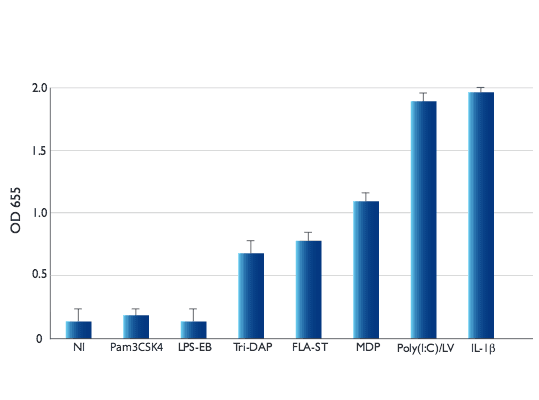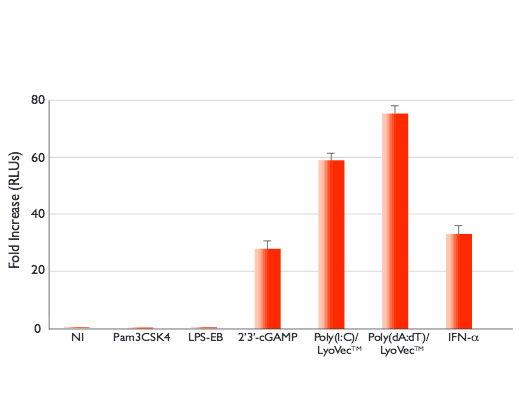HCT116-Dual™ Cells
| Product | Unit size | Cat. code | Docs. | Qty. | Price | |
|---|---|---|---|---|---|---|
|
HCT116-Dual™ Cells Human NF-κB-SEAP & IRF-Luc Reporter colorectal carcinoma |
Show product |
3-7 x 10e6 cells |
hctd-nfis
|
|
||
|
HCT116-Dual™ vial Additional cell vial |
Show product |
3-7 x 10e6 cells |
hctd-nfis-av
|
Notification: Reference #hctd-nfis-av can only be ordered together with reference #hctd-nfis.
Human HCT116 colorectal carcinoma - NF-κB & IRF reporter cells
HCT116-Dual™ cells are adherent epithelial cells that have been derived from the human HCT116 colorectal carcinoma cell line by stable integration of two inducible reporter constructs.
HCT116-Dual™ cells express a secreted embryonic alkaline phosphatase (SEAP) reporter gene under the control of the IL-12 p40 minimal promoter fused to five NF-κB and AP-1 binding sites.
HCT116-Dual™ cells also express the Lucia luciferase gene, which encodes a secreted luciferase, under the control of an ISG54 minimal promoter in conjunction with five IFN-stimulated response elements.
As a result, HCT116-Dual™ cells allow to simultaneously study the NF-κB pathway, by assessing the activity of SEAP, and the interferon regulatory factor (IRF) pathway, by monitoring the activity of Lucia luciferase.
Both reporter proteins are readily measurable in the cell culture supernatant when using QUANTI-Blue™ Solution, a SEAP detection reagent, and QUANTI-Luc™ 4 Lucia/Gaussia, a Lucia and Gaussia luciferase detection reagent.
Back to the topSpecifications
Antibiotic resistance: Blasticidin and Zeocin®
Guaranteed mycoplasma-free
Quality Control:
- For each lot, proper activation of the NF-κB pathway and IRF pathway is confirmed upon stimulation of HCT116-Dual™ cells by various pathogen associated molecular patterns (PAMPs) known to activate these pathways.
- The stability of this cell line for 20 passages following thawing has been verified.
Contents
- 1 vial of HCT116-Dual™ cells (3-7 x 106 cells)
- 1 ml of Blasticidin (10 mg/ml)
- 1 ml of Zeocin® (100 mg/ml)
- 1 ml of Normocin™ (50 mg/ml)
- 1 tube of QUANTI-Luc™ 4 Reagent, a Lucia luciferase detection reagent (sufficient to prepare 25 ml)
- 1 ml of QB reagent and 1 ml of QB buffer (sufficient to prepare 100 ml of QUANTI-Blue™ Solution, a SEAP detection reagent)
![]() Shipped on dry ice (Europe, USA, Canada, and some regions in Asia)
Shipped on dry ice (Europe, USA, Canada, and some regions in Asia)
Details
HCT116-Dual™ cells express numerous pattern recognition receptors (PRRs), including the NOD-like receptors (NLRs) NOD1 and NOD2 [1, 2], the RIG-I-like receptor (RLR) RIG-I [3, 4], and the Toll-like receptors (TLRs) TLR3 and TLR5 [5] but not TLR2 or TLR4 [2].
Upon recognition of their cognate PAMPs, these receptors induce signaling pathways leading to the activation of the transcription factors NF-kB and/or IRF3/7. Stimulation of HCT116-Dual™ cells with the following PAMPs, Poly(I:C) (TLR3), flagellin (TLR5), Tri-DAP (NOD1), and MDP (NOD2), leads to the activation of NF-kB. Stimulation with RLR ligands, such as transfected poly(I:C) or poly(dA:dT), or the STING agonist, 2’3’-cGAMP, triggers the IRF pathway.
Stimulation with RLR ligands, such as transfected poly(I:C) or poly(dA:dT), or the STING agonist, 2’3’-cGAMP, triggers the IRF pathway.
HCT116-Dual™ cells are resistant to the selectable markers blasticidin and Zeocin™.
1. Rickard DJ. et al., 2014. Identification of selective small molecule inhibitors of the nucleotide-binding oligomerization domain 1 (NOD1) signaling pathway. PLoS One. 9(5):e96737.
2. Zhao L. et al., 2007. Differential modulation of Nods signaling pathways by fatty acids in human colonic epithelial HCT116 cells. J Biol Chem. 282(16):11618-28.
3 Gack MU. et al., 2008. Roles of RIG-I N-terminal tandem CARD and splice variant in TRIM25-mediated antiviral signal transduction. PNAS. 105(43):16743-8.
4. Taura M. et al., 2008. p53 regulates Toll-like receptor 3 expression and function in human epithelial cell lines. Mol Cell Biol. 28(21):6557-67.
5. Klimosch SN. et al., 2013. Functional TLR5 genetic variants affect human colorectal cancer survival. Cancer Res. 73(24):7232-42.








